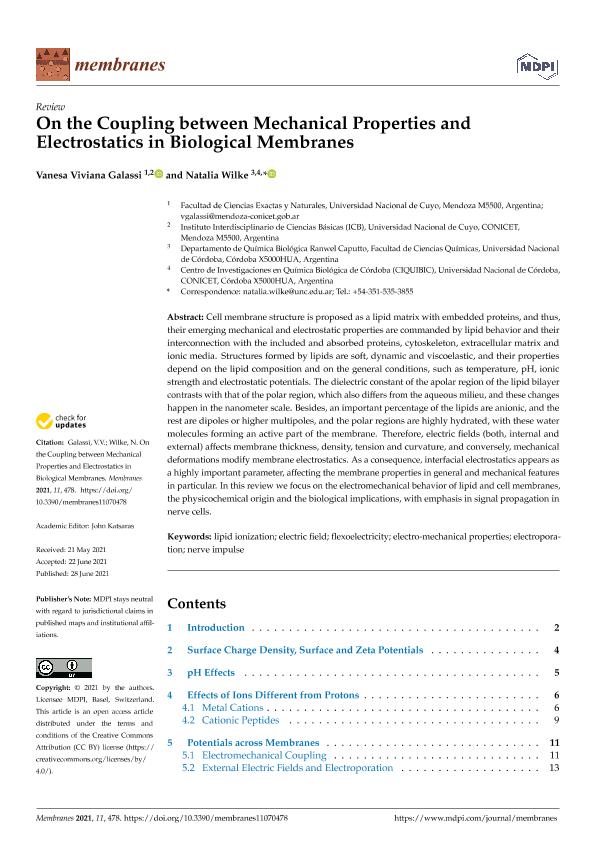Mostrar el registro sencillo del ítem
dc.contributor.author
Galassi, Vanesa Viviana

dc.contributor.author
Wilke, Natalia

dc.date.available
2022-10-14T17:02:16Z
dc.date.issued
2021-06
dc.identifier.citation
Galassi, Vanesa Viviana; Wilke, Natalia; On the coupling between mechanical properties and electrostatics in biological membranes; Multidisciplinary Digital Publishing Institute; Membranes; 11; 7; 6-2021; 1-24
dc.identifier.uri
http://hdl.handle.net/11336/173299
dc.description.abstract
Cell membrane structure is proposed as a lipid matrix with embedded proteins, and thus, their emerging mechanical and electrostatic properties are commanded by lipid behavior and their interconnection with the included and absorbed proteins, cytoskeleton, extracellular matrix and ionic media. Structures formed by lipids are soft, dynamic and viscoelastic, and their properties depend on the lipid composition and on the general conditions, such as temperature, pH, ionic strength and electrostatic potentials. The dielectric constant of the apolar region of the lipid bilayer contrasts with that of the polar region, which also differs from the aqueous milieu, and these changes happen in the nanometer scale. Besides, an important percentage of the lipids are anionic, and the rest are dipoles or higher multipoles, and the polar regions are highly hydrated, with these water molecules forming an active part of the membrane. Therefore, electric fields (both, internal and external) affects membrane thickness, density, tension and curvature, and conversely, mechanical deformations modify membrane electrostatics. As a consequence, interfacial electrostatics appears as a highly important parameter, affecting the membrane properties in general and mechanical features in particular. In this review we focus on the electromechanical behavior of lipid and cell membranes, the physicochemical origin and the biological implications, with emphasis in signal propagation in nerve cells.
dc.format
application/pdf
dc.language.iso
eng
dc.publisher
Multidisciplinary Digital Publishing Institute
dc.rights
info:eu-repo/semantics/openAccess
dc.rights.uri
https://creativecommons.org/licenses/by/2.5/ar/
dc.subject
LIPID IONIZATION
dc.subject
ELECTRIC FIELD
dc.subject
FLEXOELECTRICITY
dc.subject
ELECTRO-MECHANICAL PROPERTIES
dc.subject
ELECTROPORATION
dc.subject
NERVE IMPULSE
dc.subject.classification
Biofísica

dc.subject.classification
Ciencias Biológicas

dc.subject.classification
CIENCIAS NATURALES Y EXACTAS

dc.title
On the coupling between mechanical properties and electrostatics in biological membranes
dc.type
info:eu-repo/semantics/article
dc.type
info:ar-repo/semantics/artículo
dc.type
info:eu-repo/semantics/publishedVersion
dc.date.updated
2022-10-13T16:42:41Z
dc.identifier.eissn
2077-0375
dc.journal.volume
11
dc.journal.number
7
dc.journal.pagination
1-24
dc.journal.pais
Suiza

dc.journal.ciudad
Basilea
dc.description.fil
Fil: Galassi, Vanesa Viviana. Consejo Nacional de Investigaciones Científicas y Técnicas. Centro Científico Tecnológico Conicet - Mendoza. Instituto Interdisciplinario de Ciencias Básicas. - Universidad Nacional de Cuyo. Instituto Interdisciplinario de Ciencias Básicas; Argentina
dc.description.fil
Fil: Wilke, Natalia. Consejo Nacional de Investigaciones Científicas y Técnicas. Centro Científico Tecnológico Conicet - Córdoba. Centro de Investigaciones en Química Biológica de Córdoba. Universidad Nacional de Córdoba. Facultad de Ciencias Químicas. Centro de Investigaciones en Química Biológica de Córdoba; Argentina
dc.journal.title
Membranes
dc.relation.alternativeid
info:eu-repo/semantics/altIdentifier/url/https://www.mdpi.com/2077-0375/11/7/478
dc.relation.alternativeid
info:eu-repo/semantics/altIdentifier/doi/http://dx.doi.org/10.3390/membranes11070478
Archivos asociados
